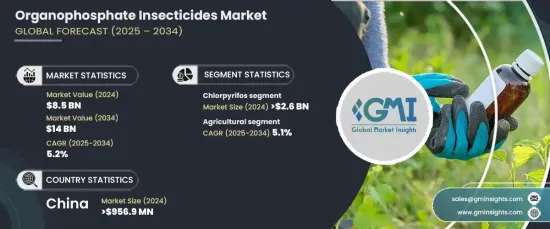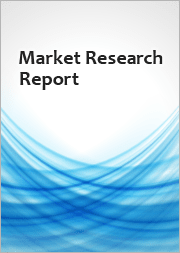
|
시장보고서
상품코드
1665184
세계의 유기인계 살충제 시장 : 기회, 성장 촉진요인, 산업 동향 분석, 예측(2025-2034년)Organophosphate Insecticides Market Opportunity, Growth Drivers, Industry Trend Analysis, and Forecast 2025 - 2034 |
||||||
세계 유기인계 살충제 시장은 2024년 85억 달러로 평가되었으며, 2025년부터 2034년까지 연평균 복합 성장률(CAGR) 5.2%를 나타낼 것으로 예측됩니다.
이 성장은 농업 용도와 비농업 용도 모두에서 매우 효과적인 해충 제거 솔루션에 대한 수요 증가를 반영합니다. 광범위한 효능으로 알려진 유기인계 살충제는 전 세계의 작물 수율과 식품 안보를 위협하는 다양한 해충을 관리하는 신뢰할 수있는 옵션입니다.

이러한 살충제는 주식 작물, 과일, 야채에 영향을 미치는 해충과 싸우는 것으로 농업 생산성을 향상시키는 데 중요한 역할을 하고 있으며, 이로 인해 빠르게 증가하는 세계 인구의 식량 안보에 크게 기여하고 있습니다. 또한 정밀농업과 대상을 좁힌 살포기술의 진보로 환경에 대한 우려를 최소화하면서 효율성을 높일 수 있어 지속가능한 사용도 뒷받침하고 있습니다. 시장 상승 궤도는 세계 농업 근대화 이니셔티브의 확대와 함께 해충 관리 솔루션의 지속적인 혁신에 의해 지원됩니다.
| 시장 범위 | |
|---|---|
| 시작 연도 | 2024년 |
| 예측 연도 | 2025-2034년 |
| 시작 금액 | 85억 달러 |
| 예측 금액 | 140억 달러 |
| CAGR | 5.2% |
클로르피리포스는 2024년 시장을 선도하여 26억 달러를 벌어들였으며, 2034년까지 연평균 복합 성장률(CAGR) 5.5%로 성장할 것으로 예측됩니다. 진딧물, 흰개미, 흰가루이 등 다양한 해충을 제거하는 능력이 입증된 것이 인기의 이유입니다. 클로르피리포스는 작물 보호 프로그램에 필수적인 존재이며, 과일, 야채, 곡물 등 주요 작물의 건강과 생산성을 확보하고 있습니다. 클로르피리포스는 그 탁월한 유효성과 농업용·공업용 용도에서의 범용성이 결합되어, 규제 프레임워크가 환경이나 건강에 배려에 대응하도록 진화해도, 그 보급을 계속 추진하고 있습니다. 이 화합물의 지속적인 관련성은 대규모 농업과 소규모 농업 모두의 해충 방제 전략에서의 중요성을 강조합니다.
2024년 유기인계 살충제 시장은 농업 부문이 64억 달러의 매출을 차지했으며 향후 10년간 CAGR 5.1%로 성장할 것으로 예상됩니다. 이 이점은 작물의 수율을 위협하는 해충을 관리하기 위해 유기 인산염에 의존한다는 것을 돋보이게합니다. 농부들이 이러한 살충제를 선호하는 이유는 비용 효과적이고 광범위하게 작용하여 곡물, 과일, 야채를 괴롭히는 해충을 표적으로 할 수 있기 때문입니다. 환경 문제와 규제 제약이 과제가 되는 한편, 기술의 진보나 정밀 농업의 도입이 유기 인산염의 효율적이고 지속 가능한 살포를 강화해, 세계의 농업에 있어서의 유기 인산염의 지위의 계속을 확실히 하고 있습니다.
중국은 2024년 9억 5,690만 달러를 기록했으며, 예측 기간 동안 CAGR 5.4%로 성장할 전망으로 세계 시장의 주요 국가로 떠올랐습니다. 중국의 이점은 광대한 농업 경관과 증가하는 인구 수요를 충족시키는 데 주력하고 있기 때문입니다. 중국은 농업의 근대화와 정밀 농업의 통합을 위해 노력하고 있기 때문에 농약의 사용량을 최적화하고 효율성을 높이고 환경에 미치는 영향을 최소화하고 있으며, 유기인계 살충제 세계 시장에서의 입지를 더욱 강화하고 있습니다.
목차
제1장 조사 방법과 조사 범위
- 시장 범위와 정의
- 기본 추정과 계산
- 예측 계산
- 데이터 소스
- 1차 데이터
- 2차 데이터
- 유료 정보원
- 공적 정보원
제2장 주요 요약
제3장 업계 인사이트
- 생태계 분석
- 밸류체인에 영향을 주는 요인
- 이익률 분석
- 파괴
- 미래의 전망
- 제조업체
- 유통업체
- 공급자의 상황
- 이익률 분석
- 주요 뉴스
- 규제 상황
- 영향요인
- 성장 촉진요인
- 세계 식품 수요 증가
- 해충에 대한 폭넓은 유효성
- 대체품과 비교한 비용효과
- 업계의 잠재적 위험 및 과제
- 엄격한 규제
- 성장 촉진요인
- 성장 가능성 분석
- Porter's Five Forces 분석
- PESTEL 분석
제4장 경쟁 구도
- 소개
- 기업 점유율 분석
- 경쟁 포지셔닝 매트릭스
- 전략 전망 매트릭스
제5장 시장 추계·예측 : 유효 성분별, 2021-2034년
- 주요 동향
- 클로르피리포스
- 말라티온
- 파라티온
- 다이아지논
- 디메토에이트
- 기타
제6장 시장 추계·예측 : 용도별, 2021-2034년
- 주요 동향
- 농업 분야
- 농작물 보호
- 토양치료
- 종자 처리
- 비농업분야
- 주택 해충 방제
- 상업 해충 방제
- 산업 해충 방제
제7장 시장 추계·예측 : 지역별, 2021-2034년
- 주요 동향
- 북미
- 미국
- 캐나다
- 유럽
- 영국
- 독일
- 프랑스
- 이탈리아
- 스페인
- 러시아
- 아시아태평양
- 중국
- 인도
- 일본
- 한국
- 호주
- 라틴아메리카
- 브라질
- 멕시코
- 중동 및 아프리카
- 남아프리카
- 사우디아라비아
- 아랍에미리트(UAE)
제8장 기업 프로파일
- Anhui GSH Bio-Technology
- Cayman Chemical Company
- Haihang Industry
- Herbo Nutra
- Kaiping Genuine Biochemical Pharmaceutical
- KOHJIN Life Sciences
- Kyowa Hakko Bio
- Meteoric Biopharmaceuticals
- Shandong Jincheng Biological Pharmaceutical
- Xi'an Fengzu Biological Technology
- YAOPHARMA
The Global Organophosphate Insecticides Market reached a valuation of USD 8.5 billion in 2024 and is anticipated to grow at a CAGR of 5.2% between 2025 and 2034. This growth reflects an escalating demand for highly effective pest control solutions in both agricultural and non-agricultural applications. Known for their broad-spectrum efficacy, organophosphate insecticides are a trusted choice for managing a wide range of pests that threaten crop yields and food security worldwide.

These insecticides play a critical role in enhancing agricultural productivity by combating pests that affect staple crops, fruits, and vegetables, thereby contributing significantly to food security in a rapidly growing global population. Advances in precision agriculture and targeted application technologies are also boosting their sustainable use, allowing for greater efficiency while minimizing environmental concerns. The market's upward trajectory is underpinned by continuous innovations in pest management solutions, alongside the expansion of agricultural modernization initiatives globally.
| Market Scope | |
|---|---|
| Start Year | 2024 |
| Forecast Year | 2025-2034 |
| Start Value | $8.5 Billion |
| Forecast Value | $14 Billion |
| CAGR | 5.2% |
Chlorpyrifos led the market in 2024, generating USD 2.6 billion, and is projected to grow at a CAGR of 5.5% through 2034. Its popularity is driven by its proven ability to control a diverse array of pests, including aphids, termites, and whiteflies. Chlorpyrifos remains an integral part of crop protection programs, ensuring the health and productivity of key crops such as fruits, vegetables, and grains. Its exceptional effectiveness, coupled with its versatility in both agricultural and industrial applications, continues to fuel its adoption, even as regulatory frameworks evolve to address environmental and health considerations. The compound's sustained relevance underscores its importance in pest control strategies for both large-scale farming operations and smaller agricultural enterprises.
The agricultural sector dominated the organophosphate insecticides market in 2024, generating USD 6.4 billion, and is expected to grow at a CAGR of 5.1% over the next decade. This dominance highlights the sector's reliance on organophosphates for managing pests that threaten crop yields. Farmers favor these insecticides for their cost-effectiveness, broad-spectrum activity, and ability to target pests that afflict cereals, fruits, and vegetables. While environmental concerns and regulatory restrictions present challenges, advancements in technology and the adoption of precision agriculture are enhancing the efficient and sustainable application of organophosphates, ensuring their continued prominence in global agriculture.
China emerged as a key player in the global market, recording USD 956.9 million in 2024 and poised to grow at a CAGR of 5.4% during the forecast period. The country's dominance stems from its vast agricultural landscape and its focus on meeting the demands of a growing population. China's commitment to agricultural modernization and the integration of precision farming practices has optimized pesticide usage, increased efficiency, and minimized environmental impact, further strengthening its position in the global market for organophosphate insecticides.
Table of Contents
Chapter 1 Methodology & Scope
- 1.1 Market scope & definitions
- 1.2 Base estimates & calculations
- 1.3 Forecast calculations
- 1.4 Data sources
- 1.4.1 Primary
- 1.4.2 Secondary
- 1.4.2.1 Paid sources
- 1.4.2.2 Public sources
Chapter 2 Executive Summary
- 2.1 Industry synopsis, 2021-2034
Chapter 3 Industry Insights
- 3.1 Industry ecosystem analysis
- 3.1.1 Factor affecting the value chain
- 3.1.2 Profit margin analysis
- 3.1.3 Disruptions
- 3.1.4 Future outlook
- 3.1.5 Manufacturers
- 3.1.6 Distributors
- 3.2 Supplier landscape
- 3.3 Profit margin analysis
- 3.4 Key news & initiatives
- 3.5 Regulatory landscape
- 3.6 Impact forces
- 3.6.1 Growth drivers
- 3.6.1.1 Increasing global food demand
- 3.6.1.2 Wide-spectrum efficacy against pests
- 3.6.1.3 Cost-effectiveness compared to alternatives
- 3.6.2 Industry pitfalls & challenges
- 3.6.2.1 Stringent regulatory restrictions
- 3.6.1 Growth drivers
- 3.7 Growth potential analysis
- 3.8 Porter’s analysis
- 3.9 PESTEL analysis
Chapter 4 Competitive Landscape, 2024
- 4.1 Introduction
- 4.2 Company market share analysis
- 4.3 Competitive positioning matrix
- 4.4 Strategic outlook matrix
Chapter 5 Market Estimates & Forecast, By Active ingredient, 2021-2034 (USD Billion) (Kilo Tons)
- 5.1 Key trends
- 5.2 Chlorpyrifos
- 5.3 Malathion
- 5.4 Parathion
- 5.5 Diazinon
- 5.6 Dimethoate
- 5.7 Others
Chapter 6 Market Estimates & Forecast, By Application, 2021-2034 (USD Billion) (Kilo Tons)
- 6.1 Key trends
- 6.2 Agricultural
- 6.2.1 Crop protection
- 6.2.2 Soil treatment
- 6.2.3 Seed treatment
- 6.3 Non-agricultural
- 6.3.1 Residential pest control
- 6.3.2 Commercial pest control
- 6.3.3 Industrial pest control
Chapter 7 Market Estimates & Forecast, By Region, 2021-2034 (USD Billion) (Kilo Tons)
- 7.1 Key trends
- 7.2 North America
- 7.2.1 U.S.
- 7.2.2 Canada
- 7.3 Europe
- 7.3.1 UK
- 7.3.2 Germany
- 7.3.3 France
- 7.3.4 Italy
- 7.3.5 Spain
- 7.3.6 Russia
- 7.4 Asia Pacific
- 7.4.1 China
- 7.4.2 India
- 7.4.3 Japan
- 7.4.4 South Korea
- 7.4.5 Australia
- 7.5 Latin America
- 7.5.1 Brazil
- 7.5.2 Mexico
- 7.6 MEA
- 7.6.1 South Africa
- 7.6.2 Saudi Arabia
- 7.6.3 UAE
Chapter 8 Company Profiles
- 8.1 Anhui GSH Bio-Technology
- 8.2 Cayman Chemical Company
- 8.3 Haihang Industry
- 8.4 Herbo Nutra
- 8.5 Kaiping Genuine Biochemical Pharmaceutical
- 8.6 KOHJIN Life Sciences
- 8.7 Kyowa Hakko Bio
- 8.8 Meteoric Biopharmaceuticals
- 8.9 Shandong Jincheng Biological Pharmaceutical
- 8.10 Xi’an Fengzu Biological Technology
- 8.11 YAOPHARMA



















